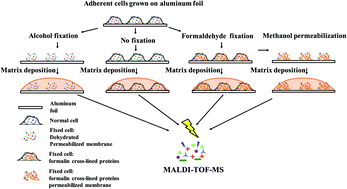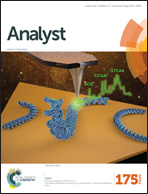Aluminium foil as a single-use substrate for MALDI-MS fingerprinting of different melanoma cell lines†
Abstract
Herein, we present the intact cell matrix-assisted laser desorption/ionization mass spectrometry (MALDI-MS) for the fingerprinting of human melanoma cancer cell lines grown on aluminium foil. To perform the MALDI-MS assay, melanoma cells were cultured on a flat and thin foil, which was directly transferred to the target plate of MALDI-MS for analysis. The influence of a wide range of cell fixation protocols (i.e. formalin-based and alcohol-based methods) and MALDI matrices on the obtained characteristic spectra was investigated. For the optimization of the MALDI-MS protocol, the MS fingerprints of the melanoma WM-239 cell line with and without an overexpressed enhanced green fluorescent protein were employed. The fingerprints obtained from WM-239 cells grown on aluminium foil were compared with the intact cell MALDI-MS of the cell pellet and presented higher sensitivity in a high m/z range. The optimized protocol was subsequently applied to characterise melanoma cell lines derived from different cancer stages and allowed identification of unique MS signals that could be used for differentiation between the studied cell lines (i.e. molecular weight equal to 10.0 kDa and 26.1 kDa).


 Please wait while we load your content...
Please wait while we load your content...